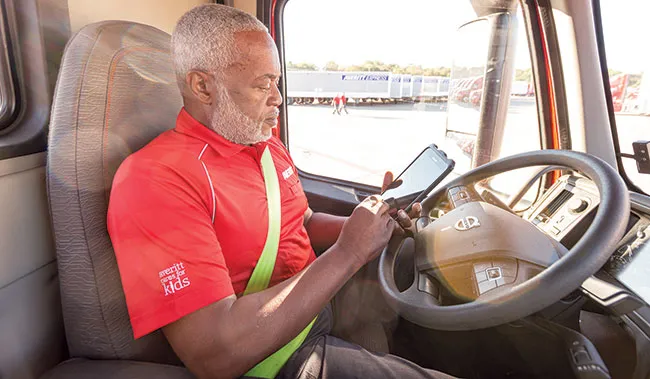Fleets Learn to Utilize In-Cab Technology

[Stay on top of transportation news: Get TTNews in your inbox.]
Some fleet operators are finding the right balance between software use and customization, recognizing they have an opportunity and a challenge: finding new technologies to map better routes, save money and simplify a wide array of functions.
When deploying transportation management systems on scale, every fleet has its own experience. Some lean heavily on in-cab technology to optimize routes, while others still let dispatch lead that effort with an assist from more familiar technology like Google Maps. Simplification is a benefit in functions like invoicing and bills of lading. All of this with the specter of artificial intelligence looming over it all.
Danny Lilley, vice president and chief technology officer at Werner, told Transport Topics the company has established its own tablet-based platform known as EDGE Connect, developed in-house by the company’s innovation arm known as Werner EDGE.
Werner Enterprises ranks No. 17 on the Transport Topics Top 100 list of the largest for-hire carriers in North America, and No. 71 on the list of top freight brokerage firms.

Lilley
“That is our telematics device, so drivers are able to do electronic logging devices, workflow and all their primary functions,” Lilley said. “We’ve upgraded that technology in the last couple of years.” The improvements, he added, were made to items like payroll and load shipments.
Lilley described the fleet’s previous solution as outdated and cumbersome. “It was forms-based, and the user interface had a pullout keyboard. There was really no workflow to it,” he described. “Our drivers would arrive at a shipper, pull through 60 different forms and fill in that data. There was a lot of manual entry. Not the best technology for our drivers.”
UniGroup uses an electronic logging device system designed by Samsara. One of its critical functions is fuel efficiency.

Pilgram
“The fuel efficiency and sustainability aspect measures and monitors to help our van operators be more fuel efficient for sustainability purposes,” said Melissa Pilgram, project safety manager at UniGroup. “We have idling reports and fuel consumption reports, and our ELD manager works with our drivers to let them know what’s going on and how they can use other safe driving tips and fuel-efficiency tips.”
The technology is teamed with ELD administrators who work with the drivers to optimize the system’s resources, and to make sure each application is customized to the capabilities of each driver and truck.
Although routing software was one of the first major technological innovations in the trucking industry, it is still a critical part today.
“Whether it’s low bridges, what traffic looks like up ahead, weather, pop-up or ongoing construction, or parking up ahead, the routing is probably the most critical thing for them to manage every day,” said Chad Dittberner, senior vice president van/expedited division for Werner.
Fleets indicated that one priority attached to route optimization is being able to give shippers more reliable estimated time of arrivals. That’s one of the focuses for Averitt, which runs the internally developed Averitt Drive Workflow app on a Samsung Tab Active3 tablet. Averitt Express ranks No. 29 on TT’s Top 100 for-hire list.
“It’s making sure we’re confirming shipment pickup, movement, delivery — those types of things,” said Amos Rogan, LTL field operations leader for Averitt. “From the perspective of customer service and customer visibility, that has become a higher demand than it was 15 years ago, when they just had to make sure we had a delivery seat for a particular shipment at the time of invoicing. Now, because of supply chain issues, we’ve seen customers looking more for ETAs, who signed for it, when they signed for it.”
From that has come a proprietary ETA engine accessible by Averitt drivers and dispatchers alike.

Fleet managers say that providing extra support for drivers goes a long way in onboarding new technology. (Averitt Express)
At Werner, route optimization is just part of the technology designed to give customers a more reliable ETA.
“It ties into the accuracy of our ETAs and our ability to let our shippers know with a high degree of confidence in our arrival times,” Lilley said. “We’ve focused on our ETAs, so I’m not sure it’s the route optimization but just being more sophisticated. Taking hours-of-service calculations into the ETA. I don’t know how you can calculate the ETA without doing that — traffic, weather.”
At Averitt, route optimization software seeks to improve the efficiency of LTL operations by giving drivers a precise plan for pickups and deliveries, with a wide variety of factors taken into consideration. According to Rogan, the software tells the driver the sequence in which they should load the trailer from a geographical standpoint. The idea is to reduce the number of miles in a run, and the hours it takes to make that run, while possibly increasing the number of shipments. Getting the process into proper sequence considers factors like receiving times and liftgates.
This is where AI has the advantage, since it takes a faster processor than the human brain to analyze all those factors and spit out a routing scheme, he continued.
“From the route sequencing standpoint, some of the software we use takes AI into account as far as traffic patterns, time of day of those traffic patterns and congestion,” he said, adding it is added benefit in metro areas like Atlanta. “You might sequence a route differently based on, you’re leaving Atlanta at 9:30 in the morning. Obviously you’re going to get on [Interstate] 285 to get anywhere, and at 10 o’clock it’s a parking lot. So let’s kick these shipments off at a time when you don’t have to deal with that on 285.”

Rogan
Rogan expects AI to play an intrinsic role in Averitt’s operations going forward, although he said that will be more prominent initially on the linehaul side than in pickup-and-delivery.
Meanwhile, Werner is developing an AI pilot program in which conversational bots will answer questions for drivers, like “What are the hours at this terminal?” or “How do I put chains on the truck?”
Many platforms have weather alerts, and fleets recognize that these come in addition to commonly available alerts on the internet. But the idea is to make weather information more of an advisory service between dispatch and the driver, rather than simply asking the driver to watch whatever app is on his or her phone.
“There are all sorts of apps and information available,” Pilgram said. “But we find that our drivers appreciate us looking out for them. We’re not here just to dispatch them. We’re here to support them, and giving out that extra support goes a long way.”
The coordination between dispatch and driver can also extend to the customer, who can also be affected by a severe weather situation. If dispatch has to tell a driver to get off the road — or the driver makes that call because he or she doesn’t feel safe — then dispatch can alert the customer that delivery might be delayed.
The evolution of in-cab technology seems to point to not only routing, maintenance and weather alerts, but the simplification of the business end for drivers as well. Items like billing, which used to require a hard-copy form brought back to the main office, can now be handled through API-driven electronic bills of lading.
“They don’t do anything except for basically fill out a form at every stop they make, whether it’s pickup or delivery,” Rogan said.

The evolution of in-cab technology has helped in advancing efficiency as well as the simplification of the business end for drivers. (UniGroup)
While the advantages of efficient routes, weather safety and overall efficiency might be obvious, there is still the question of measuring ROI for fleets’ investments in these technologies. For some of the fleet managers, coming up with those measurements is a work in progress.
“I don’t think there’s one magic bullet that quantifies ROI,” Rogan said. “We have to look at the improvement in driver satisfaction, improvement in hours and miles, what we’re able to do in terms of better equipment management and utilization. Some of the ROI is unquantifiable because we don’t know what we don’t know in many cases.”
Sometimes, in a specific situation, a fleet can see how technology paid off. If a weather alert prevented a mishap that produced a negative ripple effect, the fleet can quantify the value of the trouble they would have had without getting the driver to safety.
“We could have avoided somebody going into a flood zone, and having a time where they have to sit and wait before they go on to their next load,” Pilgram said. “We find that to be one benefit to our ROI.”
And if it turns out there is no way to precisely quantify the return on investment, some managers say they’re willing to live with that.
“Every project we go into, we like to have an ROI,” Dittberner said. “But I’d stop short of saying always because some things you just need to do. How do you figure out an ROI for weather? But you need to give them that. There are just some things you need to do, knowing they’re the right thing to do for our professional drivers but also knowing it’s not going to have an easy ROI to tie it to.”
Want more news? Listen to today's daily briefing below or go here for more info:



